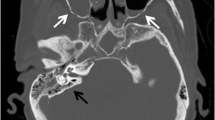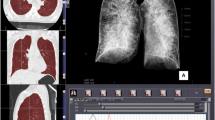Abstract
Purpose
To investigate the effectiveness of postmortem computed tomography in the diagnosis of drowning, focusing on the comparison of fresh water and salt water cases using three-dimensionally (3D) reconstructed data.
Materials and methods
We examined features of drowning in 25 fresh water drowning cases (FWDCs; 13 men, 12 women; mean age 73.1 years; range 43–95 years), and compared these with 12 salt water drowning cases (SWDCs; 5 men, 7 women; mean age 66.0 years; range 55–77 years). Pulmonary opacities, volume and density (CT number) of accumulated fluid in the paranasal sinuses and central airways, volume of the stomach/stomach contents, and cardiac blood density were examined.
Results
In SWDCs, pulmonary ground-glass opacities with wholly thickened interstitium was frequently identified (P = 0.0274). Whereas in FWDCs, a significantly larger volume and lower density of fluid in the paranasal sinuses (P = 0.0195 and P = 0.0104, respectively), lower density of fluid in the central airways (P = 0.0077), lower stomach content density (P = 0.0216), lower density in the left atrium (P = 0.0029), and a difference of density between the atria (P = 0.0247) were observed.
Conclusions
A lower density in the left atrium was observed in FWDCs compared to SWDCs. This finding may be helpful in differentiating between FWDCs and SWDCs.



Similar content being viewed by others
Change history
24 July 2019
Whereas in FWDCs, a significantly larger volume and lower density of fluid in the paranasal sinuses (<Emphasis Type="Italic">P </Emphasis>= 0.0195 and <Emphasis Type="Italic">P </Emphasis>= 0.0104, respectively), lower density of fluid in the central airways (<Emphasis Type="Italic">P </Emphasis>= 0.0077), lower stomach content density (<Emphasis Type="Italic">P </Emphasis>= 0.0216), lower density in the left atrium (<Emphasis Type="Italic">P </Emphasis>= 0.0029), and a difference of density between the atria (<Emphasis Type="Italic">P </Emphasis>= 0.0019) were observed.
References
Meddings D, Hyder AA, Ozanne-Smith J, Rahman A. Global report on drowning: preventing a leading killer. World Health Organization. Geneva: WHO Press; 2014 (ISBN 978 92 4 156478 6).
Christe A, Aghayev E, Jakowski C, Thali MJ, Vock P. Drowning–post-mortem imaging findings by computed tomography. Eur Radiol. 2008;18:283–90.
Levy AD, Harcke HT, Getz JM, Mallak CT, Caruso JL, Pearse L, et al. Virtual autopsy: two-and three-dimensional multidetector CT findings in drowning with autopsy comparison. Radiology. 2007;243:862–8.
Vander Plaetsen S, De Letter E, Piette M, Van Parys G, Casselman JW, Verstraete K. Post-mortem evaluation of drowning with whole body CT. Forensic Sci Int. 2015;249:35–41.
Usui A, Kawasumi Y, Funayama M, Saito H. Postmortem lung features in drowning cases on computed tomography. Jpn J Radiol. 2014;32:414–20.
Kawasumi Y, Kawabata T, Sugai Y, Usui A, Hosokai Y, Sato M, et al. Diagnosis of drowning using post-mortem computed tomography based on the volume and density of fluid accumulation in the maxillary and sphenoid sinuses. Eur J Radiol. 2013;82:e562–6.
Wichmann D, Obbelode F, Vogel H, Hoepker WW, Nierhaus A, Braune S, et al. Virtual autopsy as an alternative to traditional medical autopsy in the intensive care unit: a prospective study. Ann Intern Med. 2012;156:123–30.
Okuda T, Shiotani S, Sakamoto N, Kobayashi T. Background and current status of postmortem imaging in Japan: short history of “Autopsy imaging (Ai)”. Forensic Sci Int. 2013;225:3–8.
Kawasumi Y, Usui A, Sato Y, Sato Y, Daigaku N, Hosokai Y, et al. Distinction between saltwater drowning and freshwater drowning by assessment of sinus fluid on post-mortem computed tomography. Eur Radiol. 2016;26:1186–90.
Hyodoh H, Terashima R, Rokukawa M, Shimizu J, Okazaki S, Mizuo K, Watanabe S. Experimental drowning lung images on postmortem CT- Difference between sea water and fresh water. Legal Med. 2016;19:11–5.
Sakuma A, Ishii M, Yamamoto S, Shimofusa R, Kobayashi K, Motani H, Hayakawa M, et al. Application of postmortem 3D-CT facial reconstruction for personal identification. J Forensic Sci. 2010;55:1624–9.
Suzuki H, Hikiji W, Tanifiji T, Abe N, Fukunaga T. Characteristics of sudden bath-related death investigated by medical examiners in Tokyo, Japan. J Epidemiol. 2015;25:126–32.
Johkoh T, Itoh H, Müller NL, Ichikado K, Nakamura H, Ikezoe J, et al. Crazy-paving appearance at thin-section CT: spectrum of disease and pathologic findings. Radiology. 1999;211:155–60.
Lunetta P, Modell JH. Macroscopical, microscopical, and laboratory findings in drowning victims. A comprehensive review. In: Tsokos M, editor. Forensic pathology reviews, vol. 3. Totowa: Humana Press; 2005. p. 3–77.
Leth PM, Madsen BH. Drowning investigated by post mortem computed tomography and autopsy. J Forensic Radiol Imaging. 2017;9:28–30.
Giammona ST, Modell JH. Drowning by total immersion. Effects on pulmonary surfactant of distilled water, isotonic saline, and sea water. Am J Dis Child. 1967;114:612–6.
Tanaka N, Kinoshita H, Jamal M, Takakura A, Kumihashi M, Miyatake N, et al. Detection of chlorine and bromine in free liquid from the sphenoid sinus as an indicator of seawater drowning. Legal Med. 2015;17:299–303.
Yajima D, Inokuchi G, Makino Y, Motomura A, Chiba F, Torimitsu S, et al. Diagnosis of drowning by summation of sodium, potassium, and chloride ion levels in sphenoidal sinus fluid: differentiating between freshwater and seawater drowning and its application to brackish water and bathtub deaths. Forensic Sci Int. 2018;284:219–25.
Acknowledgements
The authors would like to thank Mr. Naoto Taniguchi (radiological technologist) for his advice and assistance with the reconstruction of PMCT images of the lungs.
Funding
This research received no specific grant from any funding agency in the public, commercial, or not-for-profit sectors.
Author information
Authors and Affiliations
Corresponding author
Ethics declarations
Conflict of interest
The authors have no conflicts of interest to disclose.
Ethical statement
The present study was approved by the appropriate institutional review board, who waived the requirement for informed consent due to the nature of the study.
Additional information
Publisher's Note
Springer Nature remains neutral with regard to jurisdictional claims in published maps and institutional affiliations.
Electronic supplementary material
Below is the link to the electronic supplementary material.
About this article
Cite this article
Sugawara, M., Ishiyama, K., Takahashi, S. et al. Postmortem computed tomographic features in the diagnosis of drowning: a comparison of fresh water and salt water drowning cases. Jpn J Radiol 37, 220–229 (2019). https://doi.org/10.1007/s11604-018-0802-8
Received:
Accepted:
Published:
Issue Date:
DOI: https://doi.org/10.1007/s11604-018-0802-8




